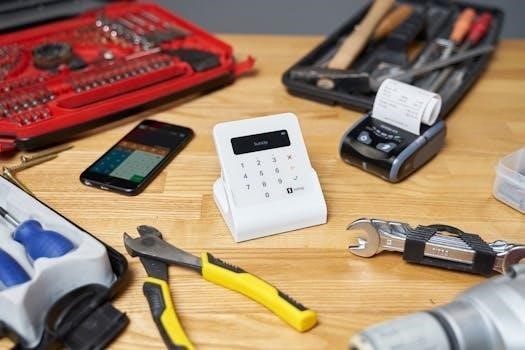ESI Phone System Manual⁚ A Comprehensive Guide
Welcome to the comprehensive guide for your ESI Phone System. This manual provides essential information for understanding, operating, and troubleshooting your phone system. Explore features, from basic call handling to advanced configurations, ensuring effective communication within your organization.
Understanding Your ESI Phone System
Before diving into the specifics of operation, understanding the core components and functionalities of your ESI Phone System is paramount. This section will explore the architecture of your system, including the various phone models, the ESI-Dex directory, and the overall system administration capabilities.
The ESI Phone System is designed to provide seamless communication, integrating features such as Caller ID, call transfer, and conference calling. This section provides a foundation for efficiently using your ESI phone, covering topics like accessing user guides and documentation. Familiarize yourself with the key terms and features to effectively utilize your ESI system.
Understanding the system’s architecture will aid in troubleshooting common issues and navigating the system’s settings. Whether you’re a new user or an experienced administrator, this overview will enhance your ability to manage calls, configure settings, and maximize the potential of your ESI communication platform. Knowing the availability of system Dexes is also important.
Basic Phone Operations
Mastering basic phone operations is essential for efficient communication. This section outlines the fundamental functions of your ESI phone, ensuring you can confidently handle everyday tasks. Learn how to power on your phone, adjust the volume, and navigate the display.
Understanding the key buttons and their functions is crucial for seamless operation. This includes the PROG/HELP button for accessing system settings, the PARK button for call management, and the ESI-DEX button for directory access. Familiarize yourself with the dial pad and its various functions, including dialing extensions and external numbers.
This section also covers essential features like muting and unmuting calls, placing calls on hold, and using the speakerphone. These basic operations form the foundation for more advanced features like call transfer and conference calling. Whether you’re a new user or need a refresher, this section provides a clear overview of the fundamental operations of your ESI phone.
Making and Answering Calls
Efficient call management begins with understanding how to make and answer calls effectively. This section provides a step-by-step guide to ensure you never miss an important communication. To make an external call, simply dial the number, and for internal calls, dial the extension.
Answering incoming calls promptly and professionally is crucial. When a call comes in, your phone will ring, and the caller ID (if enabled) will display the caller’s information. To answer, simply lift the handset or press the speakerphone button; To end a call, replace the handset or press the speakerphone button again.
For handling multiple calls, learn how to place a call on hold while answering another. This allows you to manage your calls without missing important communications. Additionally, explore the redial feature for quickly calling the last dialed number. These basic call handling techniques will improve your communication efficiency.
Call Transfer Techniques
Mastering call transfer techniques is essential for efficient communication flow. This section outlines the procedures for transferring calls to colleagues or other extensions within the ESI phone system. Two primary transfer methods exist⁚ blind transfer and announced transfer.
A blind transfer involves directly transferring the call without announcing it to the recipient. To perform a blind transfer, press the transfer button, dial the extension number, and hang up. The call is immediately transferred.
An announced transfer allows you to speak with the recipient before transferring the call. Press the transfer button, dial the extension number, and wait for the recipient to answer. Announce the call and, if the recipient accepts, hang up to complete the transfer. If they decline, press the transfer button again to return to the original caller.
Proper call transfer etiquette ensures a smooth and professional experience for both the caller and the recipient. Understanding these methods improves overall communication efficiency.
Conference Calling
Conference calling on your ESI phone system enables you to connect multiple parties in a single conversation, facilitating collaborative discussions and efficient decision-making. This section details the steps to initiate and manage conference calls effectively.
To start a conference call while on an active call, press the “Conference” button. Dial the number of the next participant you wish to add. Once they answer, press the “Conference” button again to merge them into the call. Repeat this process to add additional participants, as permitted by your system’s configuration.
During a conference call, you can manage participants by muting or disconnecting individual lines if necessary. Consult your system administrator for specific instructions on advanced conference call features.
ESI phone systems offer a streamlined approach to conference calling, enhancing team collaboration and communication efficiency. Understanding the procedures outlined above ensures seamless and productive conference calls for all participants.
Using the ESI-Dex (Directory)
The ESI-Dex, or directory, is a valuable tool for quickly accessing and dialing frequently used numbers within your ESI phone system. It streamlines the process of locating contacts, saving time and improving communication efficiency.
To access the ESI-Dex, press the “ESI-DEX” button on your phone. This will display the directory menu, which may include options such as “Personal Dex” (PER), “System Dex” (SYS), and potentially other customized directories depending on your system’s setup.

The “Personal Dex” allows you to store and manage your own frequently called contacts. The “System Dex” contains numbers programmed system-wide for easy access by all users. Navigate through the directories using the up/down arrow keys to find the desired contact.
Once you’ve located the contact, simply select it to automatically dial their number. The ESI-Dex simplifies dialing and ensures quick connections with your key contacts.
Manual Method for Adding Contacts
The manual method for adding contacts to your ESI-Dex (directory) offers a straightforward way to populate your phone’s memory with essential numbers. This process is particularly useful when you need to quickly add a contact without relying on Caller ID capture or system-wide updates.

To begin, ensure your phone is in an idle state, or immediately after receiving a dial tone. Press the “ESI-DEX” button. This action will bring up the Esi-Dex menu on your phone’s display. Navigate to the desired directory (Personal, System, etc.) where you wish to store the new contact.
Select the option to add a new entry. Your phone will prompt you to enter the contact’s name, using the keypad to spell out the name. After entering the name, proceed to input the contact’s phone number. Double-check the accuracy of the number before saving.
Once both the name and number are entered, save the contact. The new entry will now be accessible through the ESI-Dex, allowing for quick and easy dialing.
Caller ID Features
The ESI phone system’s Caller ID features enhance communication efficiency and call management. When an incoming call arrives, the Caller ID displays the caller’s name and number on your phone’s LCD screen, provided the information is available through your service provider.
During an active call or message retrieval, you can easily save the displayed Caller ID information directly to your Personal Dex. Simply press the “ESI-DEX” button while the Caller ID is visible. The system will automatically store the name and number in your personal directory.
The display will provide confirmation that the contact has been saved. This quick-save feature streamlines contact management, allowing you to build your directory with minimal effort. Furthermore, the Caller ID information can assist in screening calls and prioritizing responses.
Note that the availability of Caller ID information depends on the caller’s service provider and privacy settings. Some callers may block their information, resulting in an “Unknown” or “Private” display. Despite this, the Caller ID features significantly improve call handling capabilities within the ESI phone system.
System Administration Time Change
To adjust the time on your ESI phone system, follow these instructions. This procedure is also applicable to IVX20, IVX 128, and ESI ComServers. First, ensure the handset is hung up. Then, press the “PROG/HELP” button on your phone. Next, press the “PARK” button.
You will then be prompted to enter the administration password for your system. If you do not know the password, consult your system administrator or IT support team. After successfully entering the password, navigate to the time settings menu using the appropriate prompts or buttons as indicated on your phone’s display.
Enter the correct time, including the hour, minute, and AM/PM designation, if applicable; Save the changes according to the prompts displayed on your phone. The system time should now be updated. Verify the accuracy of the time on other phones connected to the system to ensure consistency.
Regularly updating the system time is crucial for accurate call logging, voicemail timestamps, and overall system functionality. If you encounter any issues during this process, refer to the system administrator guide or contact technical support for assistance.

Troubleshooting Common Issues
Encountering issues with your ESI phone system is sometimes inevitable, but many problems can be resolved with simple troubleshooting steps. Start by checking the power connections to the phone and the system itself. Ensure all cables are securely plugged in.
If a phone is not working, try restarting it by unplugging it for a few seconds and then plugging it back in. For network-related issues, verify that the phone is connected to the network and that the network is functioning correctly. Check the Ethernet cable and network settings.
If you are experiencing poor call quality, check your internet connection and network bandwidth. High network traffic can impact call quality. Ensure that your phone system software is up to date. Outdated software can cause compatibility issues and performance problems.
For voicemail issues, verify that your voicemail box is properly configured and that you have sufficient storage space. If you cannot access certain features, check your user permissions and system settings. Consult your system administrator if problems persist. Regularly review system logs for error messages that can provide insights into underlying issues.
Caller ID Problems
Caller ID issues on your ESI phone system can be frustrating, but they are often resolvable. If the Caller ID is not displaying, begin by verifying that the Caller ID feature is enabled on your phone line and within the system settings. Contact your service provider to ensure that Caller ID delivery is active on your account.
Check the phone system’s configuration to confirm that Caller ID information is being properly received and processed. Ensure that the phone system is compatible with the Caller ID standard used by your service provider. In some cases, incorrect settings can prevent Caller ID from displaying correctly.
If you are receiving partial or incorrect Caller ID information, there might be an issue with the data being sent by the service provider or with the phone system’s database. Consider updating the phone system’s firmware to the latest version, as updates often include fixes for Caller ID-related bugs.

If the problem persists, consult your system administrator or contact ESI support for further assistance. They can help diagnose the issue and provide specific solutions for your system configuration. Regularly test Caller ID functionality to ensure it remains operational.
Accessing User Guides and Documentation
Comprehensive user guides and documentation are essential for maximizing the capabilities of your ESI phone system. These resources provide detailed instructions, troubleshooting tips, and best practices for system administration and user operations. Accessing these materials ensures you can effectively manage and utilize your phone system.
Start by checking the official ESI website for the latest user manuals, administrator guides, and technical documentation. ESI’s online resource library often includes downloadable PDFs and video tutorials covering various aspects of the phone system. Look for documents specific to your system model and software version to ensure accuracy.
Your system administrator may have local copies of the documentation or access to a support portal with additional resources. Check internal network drives or shared document repositories for these materials. System administrators can also provide personalized training and guidance on using the phone system’s features.
Additionally, explore online forums and communities dedicated to ESI phone systems. These platforms often contain user-generated content, tips, and solutions to common issues. Always verify information from unofficial sources with the official documentation to ensure its accuracy and relevance.
